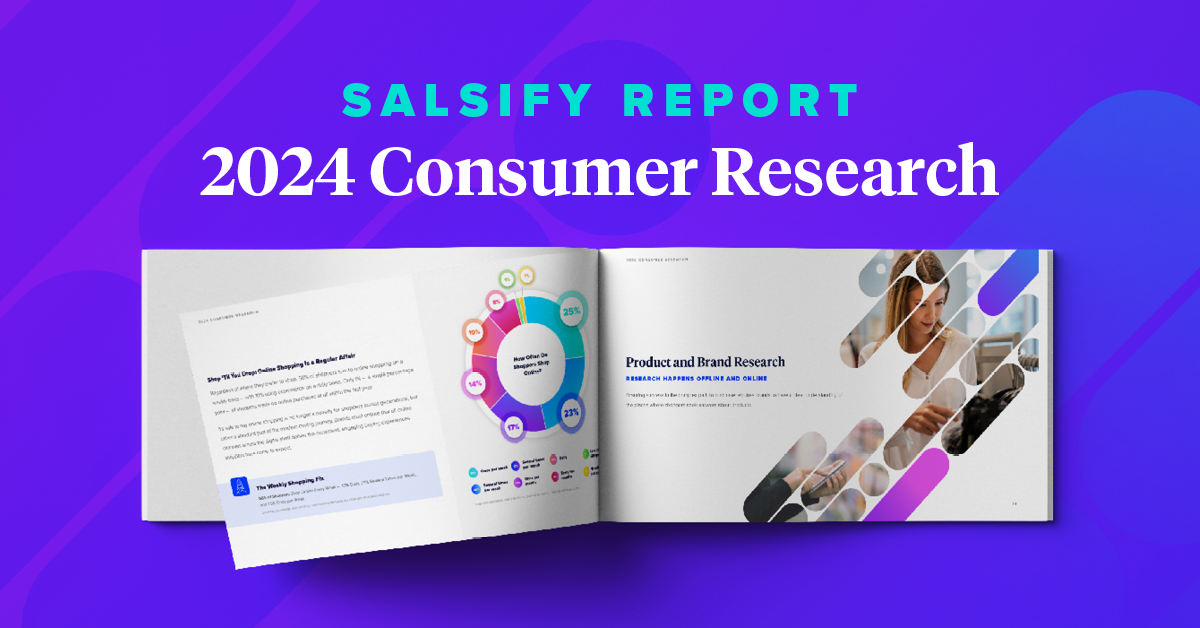Consumer Buying Behavior: How Have Spending Habits Changed in 2024?

Total consumer spending is on the rise. According to data from Trading Economics, total spend was nearly $300 billion higher in the U.S. in September 2023 than the previous year.
At the same time, however, disposable personal income is falling — compared to 2022, consumers collectively have $60 billion less to spend.
As a result, buying behavior has changed. To keep sales steady and drive consistent customer retention, brands can’t afford to fall behind.
Here’s a look at 10 top shifts in consumer buying behavior and consumer spending, what’s driving the changes, and how companies can stay ahead of the curve.
Exploring 10 Shifts in Consumer Spending
When it comes to spending habits, there’s no one-size-fits-all approach that works for every shopper in every situation. Instead, it’s a combination of factors such as price, income, product availability, and quality that ultimately drive decision-making.
Changing economic conditions, however, have set the stage for significant shifts in consumer spending habits and consumer buying behavior, such as:
1. Focusing on Budget-Friendly Options
According to the “2024 Consumer Research” report from Salsify, 39% of customers say they’re now focusing on budget-friendly buying options. It makes sense: With costs rising and disposable income shrinking, buyers must prioritize what matters to make their money go further.
2. Embracing Online Shopping
To help combat economic uncertainty, 23% of customers say they’ve embraced online shopping. The sheer volume of online options provides more choices for customers looking to find their preferred product at the right price.
3. Prioritizing Essential Purchases
Close behind budget-friendly buying is the prioritization of essential purchases, with 35% putting the essentials first.
4. Utilizing Loyalty Programs or Savings
Ideally, customers want lower prices. But this isn’t always possible — ongoing challenges with materials sourcing, supply chains, and logistics can leave companies with no choice but to increase product costs.
Options such as discounts and loyalty programs, however, can help brands connect with buyers who might otherwise pass on a purchase.
5. Engaging in More Price Comparisons
According to Statista, 82% of buyers say they often compare prices before making a purchase. For brands, this creates an incentive to ensure that product pricing is in line with competitors. If higher prices aren’t optional, brands must be prepared to clearly communicate why customers should pay more.
6. Adopting a More Cautious Approach to Impulse Buying
While impulse buying remains a solid source of revenue for brands, 26% of customers say they’re adopting a more cautious approach.
7. Exploring Secondhand or Thriftstore Options
Thrift and secondhand options are also on the rise, with 18% of consumers going this route.
8. Using Digital Coupons and Discount Apps
Digital coupons and discount apps are becoming more popular as a way for customers to save money on preferred products. Embracing this trend gives brands more opportunities to reach potential customers.
9. Reducing the Frequency of Shopping Trips
Salsify’s consumer buying behavior research also found that 19% of buyers have reduced the frequency of their shopping trips. This means brands have fewer chances to get things right. If customers walk away without making a purchase, more time between trips means more money lost for businesses.
10. Delaying or Postponing Purchases
Finally, there’s a growing trend toward delaying or postponing purchases, especially those that are more expensive. Here, brands can benefit from offering targeted discounts to consumers who have repeatedly visited specific product pages but haven’t made a purchase.
It’s also worth noting that many of these changes occur in concert. For example, buyers might increase their focus on budget-friendly options and might choose to delay or postpone purchases until products go on sale or discounts are available.
What’s Behind Buying Changes?
There are several underlying reasons for these shifts in consumer buying behavior, including inflation, accessibility, and economic uncertainty.
1. Inflation
According to Statista, While inflation rates are down from a high of 9.1% in July 2022 to 3.1% in November 2023 in the U.S., this is well above the 1.2% seen in November 2020.
With everything from food to consumer goods to energy showing sustained price increases, consumers have become more considerate and deliberate in their purchase choices.
2. Accessibility
As noted by Retail Dive, 37% of U.S. buyers made mobile purchases from November 2022 to January 2023, up from 29% the previous year. Although the uptake of mobile buying began in response to pandemic pressures, it remains popular thanks to its convenience.
Mobile solutions also make it easier for customers to compare prices and products across multiple brands simultaneously.
3. Economic Uncertainty
In the U.K., for example, 2022 government survey data found that 91% of adults said the cost of living is an important issue, and 92% said their cost of living has increased over the last year. As a result, 66% were spending less on non-essentials, and 54% were worried about heating their homes through the winter.
How Companies Can Stay Ahead of the Curve
As customer purchase habits and consumer buying behavior change, companies need ways to stay ahead of the curve. This is because staying still is effectively falling behind.
Buyers won’t wait around until your brand figures it out — instead, they’ll seek out competitors that better meet their needs. To keep pace, three strategies are critical.
1. Embrace Digital Expectations
Customers expect brands to offer digital purchasing options — and expect a seamless purchase process.
As a result, buyers are doing their homework before spending any of their hard-earned money: 43% of customers say they’re now researching reputation, customer service, and delivery times. In addition, 42% say they’ve made purchases directly through social media.
To succeed in this digital-first market, brands can’t afford a piecemeal approach. To meet buyers when, where, and how they prefer, omnichannel is the best option. This means creating consistent experiences that buyers can access anywhere, anytime, without having to start from scratch.
2. Make the Most of Brick and Mortar
Despite the rapid rise of ecommerce, brick-and-mortar stores aren’t down and out just yet, with 68% of consumers saying they still make in-store purchases. Priorities for customers buying in-store include automation and sustainability — 79% say they will change their habits based on sustainability.
For brands, making the most of brick-and-mortar means embracing automation options such as contactless payments and self-checkouts while simultaneously highlighting any efforts in sustainable sourcing and product production.
3. Prioritize Personalization
Personalization drives purchases, with 70% of U.S. consumers saying they’re more likely to buy a product if there are personally relevant images, videos, or text on product pages. In addition, companies can connect with prospective buyers by creating personalized email and sales campaigns that use historical purchase data to inform specific discounts.
For example, if customers regularly purchase the same products at a set frequency, brands can create a targeted offer for these products to help boost customer loyalty.
New Habits, New Challenges: Navigating the Next Generation of Customer Behaviors
Consumer buying behavior isn't static. Customer preferences and priorities change over time in response to market conditions, available income, and product costs. As a result, brands need to build and maintain new shopping experiences that both capture customers' attention and keep them coming back.
Achieving this goal starts with understanding what customers want right now, along with a recognition that these behaviors will evolve. By creating a digital-first, omnichannel experience that aligns with current consumer buying behavior, businesses gain the agility they need to meet existing expectations and embrace future purchase preferences.
2024 CONSUMER RESEARCH
Explore the latest consumer research and accompanying executive explainer to learn more about what's making modern consumers tick in each generation.
DOWNLOAD NOW
The Modern Buying Journey Explained
Explore Salsify's "2024 Consumer Research" report and accompanying executive explainer for insights on what's making consumers tick.
VIEW REPORTWritten by: Doug Bonderud
Doug Bonderud (he/him) is an award-winning writer with expertise in ecommerce, customer experience, and the human condition. His ability to create readable, relatable articles is second to none.
Recent Posts
Ecommerce Trends
|
11 minute read
What Is Commerce Media — and How Can It Optimize Your Marketing Spend?
Read More
Digital Shelf Summit 2025
|
3 minute read
2025 Digital Shelf Summit: Building Omnichannel Growth and Future-Ready Strategies
Read More
Digital Shelf Summit 2025
|
5 minute read
2025 Digital Shelf Summit: Big Ideas, Bold Innovation, and a Second Line to the House of Blues
Read More
Subscribe to the Below the Fold Newsletter
Standing out on the digital shelf starts with access to the latest industry content. Subscribe to Below the Fold, our monthly content newsletter, and join other commerce leaders.
2024 CONSUMER RESEARCH
Explore the latest consumer research and accompanying executive explainer to learn more about what's making modern consumers tick in each generation.
DOWNLOAD NOW

.svg)